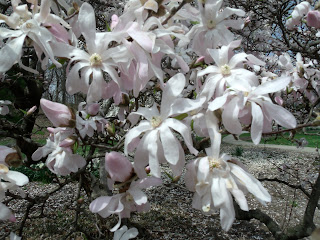Dear George,
This is the most stunning week of the year
in Southwest Ohio. It’s because
all the springtime flowering trees have suddenly burst into bloom, and the
streets and parks have turned into a festival of color. Our winter wasn’t harsh, but the chilly
temperatures went on and on, so the budding flowers were two or three weeks
late. The prettiest place that
I’ve been to lately is the Frederick A. Hinkle Magnolia Garden in Eden Park,
just west of the Krohn Conservatory.
It’s named for a long-time Park Board member in honor of his many years
of service. There are at least
half a dozen different species of magnolias planted there, and they’re
currently in full bloom. The area also includes a gazebo and a granite and
bronze fountain with the inscription, “Let Justice roll down like water and
righteousness as a mighty stream” (Amos 5:24), dedicated in honor of the late
Judge Gilbert Bettman.
Magnolias, it turns out, were
named after a French botanist, Pierre Magnol. They are the earliest known flowering plants on earth,
dating back some 130 million years.
Found on every nonarctic continent, there are about 210 different
species. They include both
evergreens and deciduous (leafy) varieties. Some magnolia trees grow as much as 90 feet tall and 50 feet
across. Their flowers can be
white, pink, purple, green, or yellow.
Magnolias rely on beetles rather than bees or butterflies for
pollination. They are considered a
southern flower in the U.S. and are the official state flowers of Louisiana and
Mississippi (which is nicknamed the Magnolia State). Magnolia bark and flower buds are used in traditional
Chinese medicine, and magnolia leaves are used to wrap food and as cooking
dishes in Japan. When
archaeologists found a 2000-year-old magnolia seed in Japan, it was planted in
1982 and produced an unusual flower with 8 petals.
I went to the Hinkle Garden
on a recent weekday morning. A
couple of young couples were walking around hand in hand. People sat on benches, relaxing in the
sunshine and taking in the view. A
majority of visitors, like myself, were photographing the flora. Here’s how the Hinkle magnolias were
looking.
Love,
Dave
SOURCES: www.ehow.com, “Interesting Facts About Magnolia
Trees”; www.ehow.com, “Interesting Facts on the
Magnolia Tree”; www.houseandhome.org,
“Magnolia Facts”; www.theflowerexpert,
“Louisiana State Flower”; www.southernliving.com,
“The Complete Guide to Magnolia Trees”; www.theblogfarm.com,
“Fun Flower Facts: Magnolia”; www.wikipedia.org,
“Magnolia”
G-mail Comments
-Donna D
(4-16): david these are the most beautiful magnolia pictures i've ever
seen! rapture was a perfect word to use. thanks!
-Phyllis S-S
(4-15): Dave, Interesting
information and gorgeous photos. Where are Hinkle gardens? Phyllis
-Linda C
(4-15): Lovely, you are ahead of us in weather, we have not really experienced
spring, maybe today counts as it is 60 degrees.




























































































































































































New reader here, Linked from a UP Post. Glad I found your Blog a lot in common UP, Cincinnati and dogs.. Great writing style. Love this post, and thought the same thing last week with the City in bloom, little ones kept saying it was snowing outside our door from falling Magnolia and Cherry trees. Thanks.
ReplyDeleteSara,
DeleteThanks for your comment. It's fun to here from somebody who also combines Cincy, UP, and dogs (there can 't be too many of us out there).
Dave L.